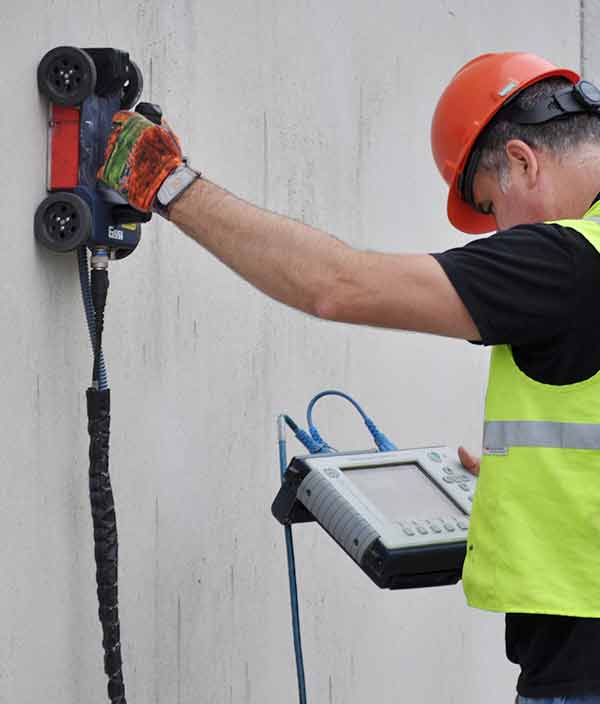Concrete Scanning: A Vital Step Towards Guaranteeing Structural Honesty and Security
In the realm of construction and facilities upkeep, the importance of concrete scanning can not be overemphasized. By utilizing sophisticated innovation and methods, concrete scanning serves as an essential device in making sure that the honesty and safety and security of bridges and structures are supported to the highest possible standards.
Significance of Concrete Scanning
Concrete scanning plays a crucial function in making certain the architectural integrity and security of structures and infrastructure tasks. By utilizing advanced modern technologies such as ground-penetrating radar (GPR) and electro-magnetic induction, professionals can non-destructively inspect concrete frameworks to detect possible problems, spaces, embedded objects, and support layout. This procedure allows very early detection of abnormalities that can compromise the security of a structure, preventing pricey problems and ensuring the security of passengers.
Concrete scanning is particularly crucial during the planning and construction stages of a task. Before drilling, cutting, or coring right into concrete, scanning assists determine the precise areas of rebar, post-tension cables, and various other embedded elements, lowering the threat of unintentional hits that can result in architectural weaknesses. In addition, concrete scanning aids in quality assurance by validating the thickness of concrete covers and detecting any type of disparities that might affect the overall longevity of the framework. Ultimately, investing in concrete scanning services is not only an aggressive action to minimize threats however also a basic step in the direction of keeping the lasting security and security of buildings and infrastructure.
Innovation for Concrete Assessment

Advantages of Early Discovery
Prompt detection of architectural issues can substantially mitigate risks and make sure the durability of construction projects. By identifying potential problems early on in the building and construction process, stakeholders can take positive measures to attend to problems prior to they escalate into bigger and much more costly issues. One of the vital advantages of early detection is the avoidance of structural failures, which can position serious security threats and lead to task delays and monetary losses.
Furthermore, early detection permits timely repair services and upkeep, which can assist extend the life-span of the framework. By dealing with problems promptly, construction teams can stay clear of expensive fixings or perhaps the need for premature replacement of structural parts. This proactive approach not just conserves money and time yet likewise enhances the general security and sturdiness of the construction project.
Additionally, very early detection can enhance project planning and decision-making by supplying stakeholders with important understandings into the problem of the framework. Equipped with this info, project managers internet can make informed selections pertaining to building and construction timelines, products, and techniques, leading to more effective and successful project results.
Making Sure Architectural Stability
Ensuring the architectural security of a building task is paramount to its safety and durability. Structural stability describes the ability of a building or facilities to preserve its kind and function under various lots and ecological problems. To achieve this, extensive evaluation and tracking of the structure are essential. Concrete scanning plays an important duty in making sure structural stability by spotting possible problems such as gaps, this page delamination, or reinforcement corrosion that could compromise the integrity of the framework in time.
By making use of sophisticated scanning modern technologies like ground-penetrating radar (GPR) and electro-magnetic induction, building and construction experts can non-invasively check concrete structures to determine locations of worry underneath the surface area. This aggressive approach permits the very early detection of weak points or flaws, enabling prompt repair work or reinforcement to stop architectural failures.
Regular concrete scanning during different construction stages and throughout the life cycle of a framework can help preserve its stability, reduce dangers, and ensure the safety of passengers. By prioritizing architectural stability via concrete scanning, building and construction tasks can boost their resilience and sturdiness, inevitably adding to greater safety and security and durability.

Avoiding Essential Failures
To safeguard versus tragic occasions, precise tracking and positive upkeep are necessary in preventing critical failures within architectural structures. Discovering possible problems before they intensify is crucial to avoid structural failures. Carrying out routine evaluations, such as concrete scanning, can expose hidden flaws like voids, fractures, or deterioration that can jeopardize the integrity of a framework. By utilizing innovative scanning modern technologies like Ground Permeating Radar (GPR) or Concrete X-ray, engineers can non-destructively examine the condition of concrete and identify weak factors that need support or repair work discover this info here - RainierGPR Service Areas.

Conclusion
In verdict, concrete scanning plays an essential duty in ensuring structural stability and safety by making use of sophisticated innovation for very early discovery of possible problems. This aggressive method helps avoid crucial failures and ensures the stability of frameworks. It is essential to prioritize concrete assessment as a typical practice to safeguard the longevity and safety of structures and facilities.
Concrete scanning plays an important duty in guaranteeing the architectural honesty and safety of buildings and framework projects. Additionally, concrete scanning help in quality control by verifying the density of concrete covers and spotting any inconsistencies that may impact the general toughness of the structure. Concrete scanning plays a critical duty in making sure structural security by identifying prospective issues such as voids, delamination, or reinforcement deterioration that can compromise the stability of the structure over time.

In final thought, concrete scanning plays a crucial role in ensuring architectural stability and safety and security by making use of innovative modern technology for very early detection of prospective problems.